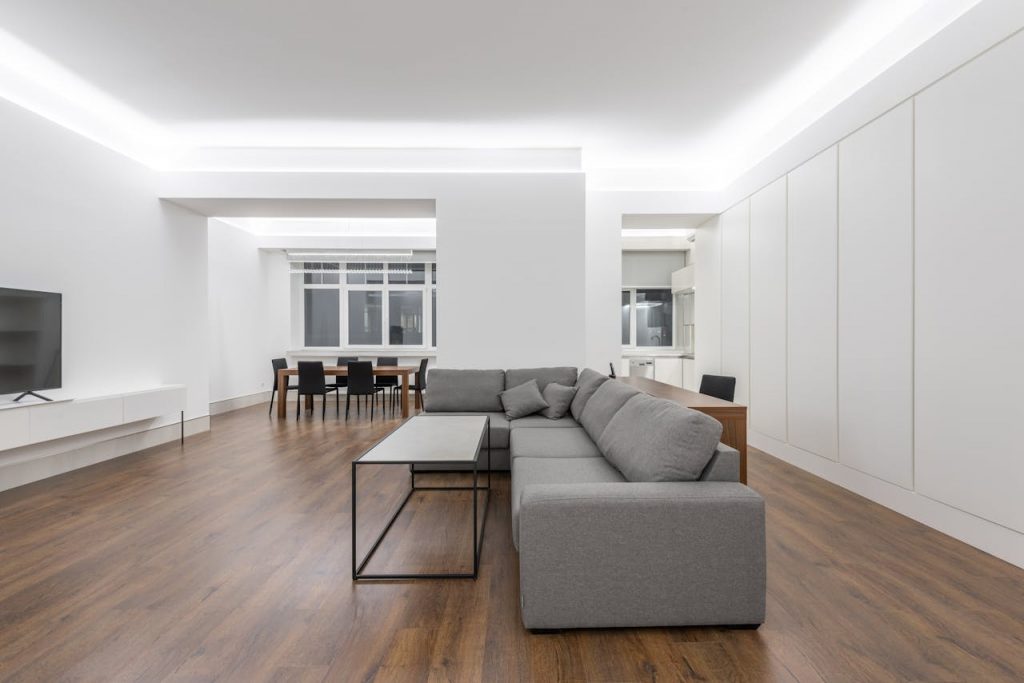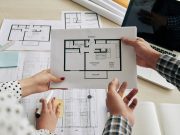Is it better to hire an interior designer or do it yourself? This is a question many real estate owners grapple with when furnishing their properties. While both options have merits, the ideal choice depends on various factors, including your budget, time constraints, design expertise, and desired outcome. Let’s explore the pros and cons of each approach to help you make an informed decision.

Understanding Your Real Estate Property
To effectively choose between retail furniture and an interior designer, it’s crucial to have a clear understanding of your real estate property. Let’s break down key factors to consider:
A. Property Type
The type of property you own significantly influences your furniture needs:
- Condominiums
Smaller spaces characterize condominiums, necessitating functional and aesthetically pleasing furniture. Opt for ergonomic furniture pieces like sofa beds or storage ottomans to maximize space efficiency. Prioritize compact and stylish furniture that complements the condominium’s overall ambiance.
- Houses
Offering more flexibility, houses allow for diverse furniture arrangements and styles. Larger pieces, such as sectional sofas and dining sets, can be incorporated. When selecting furniture, consider the property’s layout, architectural style, and desired atmosphere.
- Commercial and Office Spaces
The furniture choice depends on the property’s intended use. Ergonomic chairs, functional desks, and collaborative workspaces are essential for offices. Restaurants and cafes require durable, comfortable seating and stylish accents. Retail stores need visually appealing displays and customer-friendly furniture.
B. Target Market
Identifying your property’s target market helps tailor furniture choices to their preferences:
- Young Professionals
This demographic often prefers modern, minimalist designs with clean lines and neutral colors. Focus on functional furniture with storage solutions and incorporate technology-friendly elements.
- Families
Prioritize comfort, durability, and safety when selecting furniture for families. Opt for spacious seating options, ample storage, and child-friendly materials. Consider modular furniture that can adapt to changing family needs.
- Students
Affordability and practicality are key for students. Bunk beds, loft beds, and multifunctional furniture are popular choices. Incorporate bright colors and playful accents to create a lively atmosphere.
C. Budget Considerations
Your budget plays a vital role in determining furniture options:
- High Budget
Invest in high-quality materials, custom-made pieces, and designer furniture. Explore luxury brands and unique designs to create a sophisticated ambiance.
- Medium Budget
Balance style and affordability by combining retail finds with a few statement pieces. Maximize your budget by looking for sales, discounts, and furniture rental options.
- Low Budget
Focus on essential furniture pieces and prioritize function over aesthetics. Explore budget-friendly retailers, secondhand markets, and DIY options.
By carefully considering these factors, you can create a solid foundation for making informed decisions about furnishing your real estate property.
The Retail Furniture Route
Opting for retail furniture offers several advantages and challenges. Let’s weigh the pros and cons:
A. Pros of Retail Furniture
- Cost-Effectiveness
Buying furniture directly from retailers often costs less than engaging an interior designer. You have more control over your budget and can allocate funds to other aspects of your property.
- Variety
Retail stores boast a selection of furniture styles, materials, and price points. You can explore different options to find pieces that perfectly match your taste and the property’s aesthetic.
- Flexibility
Retail furniture allows for easy replacements and rearrangements. Retail furniture offers flexibility, allowing for easy adaptation to changes in decor or when selling the property.
B. Cons of Retail Furniture
- Time-Consuming
Selecting furniture from various retailers can be time-consuming. Researching options, visiting stores, and coordinating deliveries require significant effort.
- Lack of Cohesion
Creating a cohesive look with furniture from multiple sources can be challenging. Ensuring that styles, colors, and materials complement each other requires careful planning and coordination.
- Quality Concerns
Furniture quality varies widely among retailers. Investing in durable and long-lasting pieces may require additional research and potentially higher costs.
C. Tips for Success with Retail Furniture
To maximize the potential of retail furniture, consider the following tips:
- Create a Mood Board
Visualize your desired aesthetic by creating a mood board with images of furniture, colors, and textures. This will help you stay focused and make consistent choices.
- Measure Accurately
Take precise measurements of your rooms to avoid purchasing furniture that doesn’t fit. Consider using floor plans or sketching out room layouts.
- Prioritize Functionality
Choose furniture that serves a practical purpose while also looking good. Consider multifunctional pieces to optimize space utilization.
- Mix and Match
Try to combine different styles and periods to create a unique look. However, ensure that the pieces complement each other.
You can successfully furnish your property with retail furniture by carefully considering these factors and implementing effective strategies.
The Interior Designer Advantage
Hiring an interior designer offers a professional approach to furnishing your real estate property. Let’s explore the benefits and considerations:
A. Pros of Hiring an Interior Designer
- Professional Expertise
Interior designers possess in-depth knowledge of design principles, color theory, and space planning. They can create functional and aesthetically pleasing spaces tailored to your property and target market.
- Time-Saving
Designers streamline the process of furniture selection and purchasing by leveraging their industry connections and expertise. This saves you valuable time and effort.
- Cohesive Design
Interior designers excel at creating a unified and harmonious look throughout your property. They can coordinate furniture, colors, and accessories to achieve a cohesive aesthetic.
- Increased Property Value
A professionally designed interior can significantly enhance your property’s value. Potential buyers or tenants are often drawn to well-appointed spaces.
B. Cons of Hiring an Interior Designer
- Cost
Hiring an interior designer comes with additional expenses beyond furniture costs. Fees vary depending on the designer’s experience and project scope.
- Limited Choices
Compared to retail furniture shopping, designers may offer a wide range of options with less control over specific furniture selections.
Choosing the Right Interior Designer
To ensure a successful collaboration, meticulously select an interior designer who aligns with your vision and budget. Consider the following:
- Portfolio Review
Assess the designer’s previous work to ensure their style matches your preferences.
- Communication
Effective communication is essential. Choose a designer who listens to your needs and provides clear guidance.
- Budget Discussion
Communicate your budget expectations upfront to avoid surprises.
- References
Seek recommendations from friends, family, or other real estate professionals.
You can transform your property into a captivating and inviting space by partnering with a skilled interior designer.
Comparing Costs: Retail Furniture vs. Interior Designer
Cost is considered one of the most significant factors in deciding between retail furniture and interior designers. Let’s break down the expenses involved in each option:
A. Breakdown of Expenses
Retail Furniture
- Furniture purchase: Cost varies depending on quantity, quality, and style.
- Delivery and assembly fees: Additional expenses to consider.
- Accessories and décor: Budget for items like rugs, curtains, and artwork.
Interior Designer
- Designer fees: Hourly rates, project-based fees, or a percentage of the project’s total cost.
- Furniture and accessories: Cost of items sourced by the designer, often with a markup.
- Additional services: Potential fees for project management, installation, and styling.
Long-Term Value: While hiring an interior designer may incur upfront costs, it can lead to long-term value. A professionally designed space can increase property value, attract tenants or buyers, and create a more enjoyable living or working environment.
B. Factors Affecting Costs
Several factors influence the overall cost of furnishing your property:
- Property size
Larger spaces naturally require more furniture, impacting both retail and designer costs.
- Desired style
High-end or custom furniture can significantly increase expenses.
- Furniture quality
Investing in durable, high-quality pieces may have a higher initial cost but can save money in the long run.
By carefully considering these factors and creating a detailed budget, you can make an informed decision about allocating funds for furniture and design.
Making the Right Choice
Ultimately, deciding between retail furniture and an interior designer depends on your needs, preferences, and budget. Let’s explore factors to consider when making your choice:
A. Consider Your Goals
- Time Constraints
Hiring an interior designer can save you time and stress if you have a tight deadline.
- Design Expertise
If you lack design experience, an interior designer can provide valuable guidance and create a cohesive look.
- Budget
Evaluate your financial resources and determine if you can afford to hire a designer or if the retail route is more feasible.
- Desired Outcome
Consider the overall atmosphere you want to create and whether you prefer a DIY approach or professional assistance.
B. The Hybrid Approach
Sometimes, a combination of retail furniture and interior design services can be beneficial. You can hire a designer for initial consultation, space planning, and furniture selection, then purchase furniture independently. This approach allows you to maintain some control over the process while benefiting from professional expertise.
C. Recommendations
- Small Budget, Limited Time
Opt for affordable retail furniture and focus on functional pieces. Prioritize comfort and practicality over design.
- High-End Property
Investing in professional interior design can significantly enhance the property’s value and appeal to potential buyers or tenants.
- Indecisive or Overwhelmed
Hiring an interior designer can provide clarity and direction, especially for complex spaces or specific design styles.
By carefully considering your priorities and exploring different options, you can make an informed decision that best suits your real estate property and goals.
Conclusion
Choosing between retail furniture and an interior designer is a significant decision that impacts your real estate property, and its overall look, feel, and functionality. Both options have their advantages and drawbacks.
Retail furniture offers affordability, flexibility, and a wide range of choices. However, creating a cohesive and visually appealing space requires time, effort, and design expertise.
Hiring an interior designer provides professional expertise, time-saving benefits, and a cohesive design. While it involves additional costs, it can increase property value and create a more enjoyable living or working environment with your investment.
Ultimately, the best choice depends on your specific needs, preferences, and budget. Carefully consider your goals, time constraints, design expertise, and desired outcomes to make an informed decision.
Remember, a well-furnished property can significantly impact your real estate investment’s overall appeal and value. By thoughtfully weighing the pros and cons of each option, you can create a space that looks great and meets the needs of your target market.
Call to Action
Ready to transform your real estate property? Whether you’re leaning towards the DIY approach with retail furniture or seeking professional guidance from an interior designer, we’re here to help.
Contact HousingInteractive today to discuss your project and explore your options. Our team of experts can provide valuable insights and recommendations, and we can even connect you with trusted interior designers or furniture retailers. Let us create a space that maximizes your property’s value and looks stunning.
Common Questions About Retail Furniture and Interior Design
Q: How much does an interior designer service cost in the Philippines?
A: The cost of hiring an interior designer in the Philippines varies depending on factors such as project scope, designer experience, and the complexity of the design. It’s best to get quotes from multiple designers to compare prices and services.
Q: Can I mix and match retail furniture with pieces from an interior designer?
A: Absolutely! Combining retail furniture with designer pieces can create a unique and personalized look. However, it’s essential to ensure that the styles and finishes complement each other.
Q: What factors should I consider when choosing an interior designer?
A: When selecting an interior designer, look for someone with experience in your desired style, good communication skills, and a portfolio that aligns with your vision. It’s also important to discuss your budget and project timeline upfront.
Q: How long does an interior design project typically take to complete?
A: The duration of an interior design project depends on the project’s scope and complexity. Smaller projects may take a few weeks, while larger renovations can take several months.
Q: Can an interior designer help me with furniture selection and purchasing?
A: Yes, many interior designers offer furniture sourcing and purchasing services. They can help you find pieces that fit your style and budget.
Glossary of Terms
Retail Furniture: Purchased directly from stores or online retailers.
Interior Designer: A professional who plans and designs interior spaces.
Cohesive Design: A visually appealing and harmonious furniture arrangement, colors, and accessories.
Mood Board: A visual representation of a desired aesthetic, often used for interior design projects.
Ergonomic Furniture: Furniture designed to promote comfort and efficiency.

























